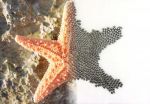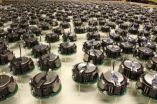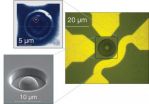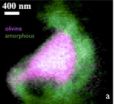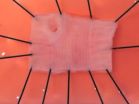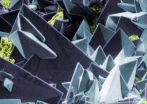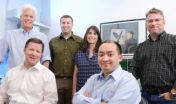(Press-News.org) Cambridge, Mass. – August 14, 2014 – The first thousand-robot flash mob has assembled at Harvard University.
"Form a sea star shape," directs a computer scientist, sending the command to 1,024 little bots simultaneously via an infrared light. The robots begin to blink at one another and then gradually arrange themselves into a five-pointed star. "Now form the letter K."
The 'K' stands for Kilobots, the name given to these extremely simple robots, each just a few centimeters across, standing on three pin-like legs. Instead of one highly-complex robot, a "kilo" of robots collaborate, providing a simple platform for the enactment of complex behaviors.
Just as trillions of individual cells can assemble into an intelligent organism, or a thousand starlings can form a great flowing murmuration across the sky, the Kilobots demonstrate how complexity can arise from very simple behaviors performed en masse (see video). To computer scientists, they also represent a significant milestone in the development of collective artificial intelligence (AI).
This self-organizing swarm was created in the lab of Radhika Nagpal, Fred Kavli Professor of Computer Science at the Harvard School of Engineering and Applied Sciences (SEAS) and a Core Faculty Member at the Wyss Institute for Biologically Inspired Engineering at Harvard University. The advance is described in the August 15 issue of Science.
"The beauty of biological systems is that they are elegantly simple—and yet, in large numbers, accomplish the seemingly impossible," says Nagpal. "At some level you no longer even see the individuals; you just see the collective as an entity to itself."
"Biological collectives involve enormous numbers of cooperating entities—whether you think of cells or insects or animals—that together accomplish a single task that is a magnitude beyond the scale of any individual," says lead author Michael Rubenstein, a research associate at Harvard SEAS and the Wyss Institute.
He cites, for example, the behavior of a colony of army ants. By linking together, they can form rafts and bridges to cross difficult terrain. Social amoebas do something similar at a microscopic scale: when food is scarce, they join together to create a fruiting body capable of escaping the local environment. In cuttlefish, color changes at the level of individual cells can help the entire organism blend into its surroundings. (And as Nagpal points out—with a smile—a school of fish in the movie Finding Nemo also collaborate when they form the shape of an arrow to point Nemo toward the jet stream.)
"We are especially inspired by systems where individuals can self-assemble together to solve problems," says Nagpal. Her research group made news in February 2014 with a group of termite-inspired robots that can collaboratively perform construction tasks using simple forms of coordination.
But the algorithm that instructs those TERMES robots has not yet been demonstrated in a very large swarm. In fact, only a few robot swarms to date have exceeded 100 individuals, because of the algorithmic limitations on coordinating such large numbers, and the cost and labor involved in fabricating the physical devices.
The research team overcame both of these challenges through thoughtful design.
Most notably, the Kilobots require no micromanagement or intervention once an initial set of instructions has been delivered. Four robots mark the origin of a coordinate system, all the other robots receive a 2D image that they should mimic, and then using very primitive behaviors—following the edge of a group, tracking a distance from the origin, and maintaining a sense of relative location—they take turns moving towards an acceptable position. With coauthor Alejandro Cornejo, a postdoctoral fellow at Harvard SEAS and the Wyss Institute, they demonstrated a mathematical proof that the individual behaviors would lead to the right global result.
The Kilobots also correct their own mistakes. If a traffic jam forms or a robot moves off-course—errors that become much more common in a large group—nearby robots sense the problem and cooperate to fix it.
To keep the cost of the Kilobot down, each robot moves using two vibrating motors that allow it to slide across a surface on its rigid legs. An infrared transmitter and receiver allow it to communicate with a few of its neighbors and measure their proximity—but the robots are myopic and have no access to a bird's-eye view. These design decisions come with tradeoffs, as Rubenstein explains: "These robots are much simpler than many conventional robots, and as a result, their abilities are more variable and less reliable," he says. "For example, the Kilobots have trouble moving in a straight line, and the accuracy of distance sensing can vary from robot to robot."
Yet, at scale, the smart algorithm overcomes these individual limitations and guarantees—both physically and mathematically—that the robots can complete a human-specified task, in this case assembling into a particular shape. That's an important demonstration for the future of distributed robotics, says Nagpal.
"Increasingly, we're going to see large numbers of robots working together, whether its hundreds of robots cooperating to achieve environmental cleanup or a quick disaster response, or millions of self-driving cars on our highways," she says. "Understanding how to design 'good' systems at that scale will be critical."
For now, the Kilobots provide an essential test bed for AI algorithms.
"We can simulate the behavior of large swarms of robots, but a simulation can only go so far," says Nagpal. "The real-world dynamics—the physical interactions and variability—make a difference, and having the Kilobots to test the algorithm on real robots has helped us better understand how to recognize and prevent the failures that occur at these large scales."
The Kilobot robot design and software, originally created in Nagpal's group at Harvard, are available open-source for non-commercial use. The Kilobots have also been licensed by Harvard's Office of Technology Development to K-Team, a manufacturer of small mobile robots.
INFORMATION:
This research was supported in part by the Wyss Institute and by the National Science Foundation (CCF-0926148, CCF-0643898).
A self-organizing thousand-robot swarm
Following simple programmed rules, autonomous robots arrange themselves into vast, complex shapes
2014-08-14
ELSE PRESS RELEASES FROM THIS DATE:
Molecular engineers record an electron's quantum behavior
2014-08-14
A team of researchers led by the University of Chicago has developed a technique to record the quantum mechanical behavior of an individual electron contained within a nanoscale defect in diamond. Their technique uses ultrafast pulses of laser light both to control the defect's entire quantum state and observe how that single electron state changes over time. The work appears in this week's online Science Express and will be published in print later this month in Science.
This research contributes to the emerging science of quantum information processing, which demands ...
Mysteries of space dust revealed
2014-08-14
The first analysis of space dust collected by a special collector onboard NASA's Stardust mission and sent back to Earth for study in 2006 suggests the tiny specks, which likely originated from beyond our solar system, are more complex in composition and structure than previously imagined.
The analysis, completed at a number of facilities including the U.S. Department of Energy's Lawrence Berkeley National Lab (Berkeley Lab) opens a door to studying the origins of the solar system and possibly the origin of life itself.
"Fundamentally, the solar system and everything ...
New Milky Way maps help solve stubborn interstellar material mystery
2014-08-14
An international team of sky scholars, including a key researcher from Johns Hopkins, has produced new maps of the material located between the stars in the Milky Way. The results should move astronomers closer to cracking a stardust puzzle that has vexed them for nearly a century.
The maps and an accompanying journal article appear in the Aug. 15 issue of the journal Science. The researchers say their work demonstrates a new way of uncovering the location and eventually the composition of the interstellar medium—the material found in the vast expanse between star systems ...
CF mucus defect present at birth
2014-08-14
VIDEO:
This is a 3-D reconstruction from time-lapse CT-scans of a CF pig lung. Images show the trachea and bronchi. Colored round dots represent positions of particles that were...
Click here for more information.
Mucus is key to keeping our lungs clean and clear of bacteria, viruses, and other foreign particles that can cause infection and inflammation. When we inhale microbes and dust, they are trapped in the mucus and then swept up and out of the lungs via a process called ...
Potential drug therapy for kidney stones identified in mouse study
2014-08-14
Anyone who has suffered from kidney stones is keenly aware of the lack of drugs to treat the condition, which often causes excruciating pain.
A new mouse study, however, suggests that a class of drugs approved to treat leukemia and epilepsy also may be effective against kidney stones, researchers at Washington University School of Medicine in St. Louis report.
The drugs are histone deacetylase inhibitors, or HDAC inhibitors for short. The researchers found that two of them — Vorinostat and trichostatin A — lower levels of calcium and magnesium in the urine. Both calcium ...
Broader organ sharing won't harm liver transplant recipients
2014-08-14
New research shows that broader sharing of deceased donor livers will not significantly increase cold ischemia time (CIT)—the time the liver is in a cooled state outside the donor suggesting that this is not a barrier to broader sharing of organs. However, findings published in Liver Transplantation, a journal of the American Association for the Study of Liver Diseases and the International Liver Transplantation Society, do indicate that broader sharing of organs will significantly increase the percentage of donor organs that are transported by flying rather than driving. ...
Scientists study 'talking' turtles in Brazilian Amazon
2014-08-14
AUDIO:
These are vocalizations made between adults and hatchlings (individual sounds repeated for the listener's benefit).
Click here for more information.
Turtles are well known for their longevity and protective shells, but it turns out these reptiles use sound to stick together and care for young, according to the Wildlife Conservation Society and other organizations.
Scientists working in the Brazilian Amazon have found that Giant South American river turtles actually ...
Scientists fold RNA origami from a single strand
2014-08-14
RNA origami is a new method for organizing molecules on the nanoscale. Using just a single strand of RNA, many complicated shapes can be fabricated by this technique. Unlike existing methods for folding DNA molecules, RNA origamis are produced by enzymes and they simultaneously fold into pre-designed shapes. These features may allow designer RNA structures to be grown within living cells and used to organize cellular enzymes into biochemical factories. The method, which was developed by researchers from Aarhus University (Denmark) and California Institute of Technology ...
New analysis links tree height to climate
2014-08-14
MADISON, Wis. — What limits the height of trees? Is it the fraction of their photosynthetic energy they devote to productive new leaves? Or is it their ability to hoist water hundreds of feet into the air, supplying the green, solar-powered sugar factories in those leaves?
Both factors — resource allocation and hydraulic limitation — might play a role, and a scientific debate has arisen as to which factor (or what combination) actually sets maximum tree height, and how their relative importance varies in different parts of the world.
In research to be published in ...
New gene editing method shows promising results for correcting muscular dystrophy
2014-08-14
DALLAS – August 14, 2014 – UT Southwestern Medical Center researchers successfully used a new gene editing method to correct the mutation that leads to Duchenne muscular dystrophy (DMD) in a mouse model of the condition.
Researchers used a technique called CRISPR/Cas9-mediated genome editing, which can precisely remove a mutation in DNA, allowing the body's DNA repair mechanisms to replace it with a normal copy of the gene. The benefit of this over other gene therapy techniques is that it can permanently correct the "defect" in a gene rather than just transiently adding ...
LAST 30 PRESS RELEASES:
The Ceramic Society of Japan’s Oxoate Ceramics Research Association launches new international book project
Heart-brain connection: international study reveals the role of the vagus nerve in keeping the heart young
Researchers identify Rb1 as a predictive biomarker for a new therapeutic strategy in some breast cancers
Survey reveals ethical gaps slowing AI adoption in pediatric surgery
Stimulant ADHD medications work differently than thought
AI overestimates how smart people are, according to HSE economists
HSE researchers create genome-wide map of quadruplexes
Scientists boost cell "powerhouses" to burn more calories
Automatic label checking: The missing step in making reliable medical AI
Low daily alcohol intake linked to 50% heightened mouth cancer risk in India
American Meteorological Society announces Rick Spinrad as 2026 President-Elect
Biomass-based carbon capture spotlighted in newly released global climate webinar recording
Illuminating invisible nano pollutants: advanced bioimaging tracks the full journey of emerging nanoscale contaminants in living systems
How does age affect recovery from spinal cord injury?
Novel AI tool offers prognosis for patients with head and neck cancer
Fathers’ microplastic exposure tied to their children’s metabolic problems
Research validates laboratory model for studying high-grade serous ovarian cancer
SIR 2026 delivers transformative breakthroughs in minimally invasive medicine to improve patient care
Stem Cell Reports most downloaded papers of 2025 highlight the breadth and impact of stem cell research
Oxford-led study estimates NHS spends around 3% of its primary and secondary care budget on the health impacts of heat and cold in England
A researcher’s long quest leads to a smart composite breakthrough
Urban wild bees act as “microbial sensors” of city health.
New study finds where you live affects recovery after a hip fracture
Forecasting the impact of fully automated vehicle adoption on US road traffic injuries
Alcohol-related hospitalizations from 2016 to 2022
Semaglutide and hospitalizations in patients with obesity and established cardiovascular disease
Researchers ‘listen in’ to embryo-mother interactions during implantation using a culture system replicating the womb lining
How changing your diet could help save the world
How to make AI truly scalable and reliable for real-time traffic assignment?
Beyond fragmented markets: A new framework for efficient and stable ride-pooling
[Press-News.org] A self-organizing thousand-robot swarmFollowing simple programmed rules, autonomous robots arrange themselves into vast, complex shapes
